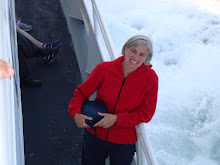1. I love the alliterative action that occurs when each animal escapes the sled. Would you please talk about why you chose to use alliterative phrases when each animal exits the sled?
I confess, I'm a sucker for alliteration. If I'd been a 1950s movie star, I'd definitely have been one of the alliteration queens like Marilyn Monroe or Diana Dors. Also, I knew this would be a way to strengthen the educational opportunities within the text, which already has several lesson-friendly elements such as numbers (counting-down) and science (arctic animals.)
I never make education the main focus of any of my books; it's always about simply creating a fun book, at the start. But once I've gotten down the bones, I do try to think in terms of educational possibilities. Choosing alliterative verbs serves several functions. First, it adds to the quality of language. To me, sounds are as important in language as meaning, especially because I mostly write picture books, which are meant to be read aloud.
Secondly, I think of verbs as the engine of any sentence. The stronger the engine, the farther the "car" (the sentence) will take me. I always tell older elementary students during author school visits that I'd rather use a single strong verb than a weak verb propped up by an adverb. And, of course, choosing a different verb for each animal also stretches the vocabulary in the book. Even if it's a verb with which the young reader is unfamiliar, LIza Woodruff's marvelous (and hilarious!) illustrations make it clear to the reader exactly what's happening in each scene.
2. In addition to alliteration, each spread uses different action words that rhyme. Would you please talk about one rhyming action pair that was particularly challenging or one rhyming action pair that you thought of immediately?
That wasn't too hard, although it might have become a bigger challenge if I'd had to write more than ten stanzas. Some couplets were easy because certain words about a sled race, (snowing/going, riding/gliding) were easy to rhyme. Two couplets that were hardest to come up with were,
"Great thunder! Duck under!" (where Liza shows the sledders ducking under fir trees)
and "We're lighter! Hold tighter!" (immediately after the heavy walrus has "whirled out.")
Reading the words now, paired with Liza's illustrations, those couplets seem very organic to the story. But the words came long before the illustrations were drawn, so it wasn't as obvious back then. I had to think in terms of visual scenes, asking myself, "What else could happen during this race?" In picture book writing, the author always has to come up with visual variety in the actions so that the illustrator isn't just drawing the same scene over and over again.
3. How did you come up with the idea of having the snowball race the sled?
I wish I could take the credit, but it's all thanks to my lovely critique group, which includes clever Joe Kulka (www.joekulka.com) an illustrator in my group. The first draft I submitted to the group was much more stagnant and true to its inspiration, "Ten in the Bed." I had everyone falling off the sled, but not much else happening. Joe read the manuscript and said, "This is fine, but let's remember this is a sled, a much more dynamic setting than a bed." Then he described how he would illustrate the story; that he'd show the ejected animals collecting into a big snowball which begins to race with the sled. I quickly rewrote, based on Joe's brilliant suggestion. I think it was at that point that I came up with the alliterative "falling-off" verbs, but I can't remember exactly. Perhaps I had already employed that device in the first draft.
4. I know you live in Virginia, but have you ever been sledding?
Not often, I confess. I like to brag that we have the best sledding hill in town, right behind our house. That's true, but since we live in a town on a relatively flat, tidal plain, it's pretty anemic in comparison to magnificent Alaskan mountains. Coincidentally, as I write this, there are sledders behind my house, since we had a little snowfall last night. That's another reason I don't often get to enjoy sledding, since snow is not as common here in southeastern Virginia as in Maine, where many of my relatives live.
5. Is there anything else you’d like to tell us?
Just that I'm pleased to be featured on your blog, Kate, and really grateful for the clever lessons you created to go with my book! Thank you so much!
It's my pleasure. Thank you, Kim, for the fantastic book!
Subscribe to:
Post Comments (Atom)

No comments:
Post a Comment